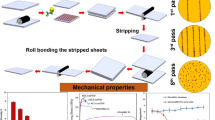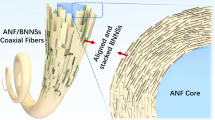Abstract
Aluminum and its alloys are still promising next-generation materials. The application of aluminum-matrix composite materials is the priority for some mechanical engineering industries. Discontinuous Al2O3 nanofibers are most promising and poorly studied as a reinforcing phase for aluminum. There are several technological problems, the solution of which enables one to implement the potential of aluminum by achieving its new characteristics. We propose a technique for an efficient introduction of light nanofibers about 10 nm in diameter using transport powders. Copper powders of different fractions are rubbed with nanofibers to form conglomerates to be introduced into the aluminum melt. The structure of the fabricated specimens is examined, the hardness is measured, and the behavior of the material under impact loads is estimated. Comparative studies of the structure and properties of the reinforced material and the initial material showed greater efficiency of the copper powder with a particle size of 180–200 μm under these conditions. The reinforcement of aluminum with Al2O3 nanofibers creates a modifying effect and enhances its mechanical properties.



Similar content being viewed by others
REFERENCES
Yu. A. Kurganova, T. A. Chernyshova, L. I. Kobeleva, and S. V. Kurganov, “Service properties of aluminum-matrix precipitation-hardened composite materials and the prospects of their use on the modern structural material market,” Russ. Metall. (Metally), No. 7, 663–666 (2011). https://doi.org/10.1134/s003602951107010x
G. A. Kosnikov, “Liquidphase production technologies of alumomatrix nanocomposite billets (review),” J. Sib. Fed. Univ., Eng. Technol., No. 7, 409–415 (2014).
A. D. Romanov, E. A. Chernyshov, V. V. Mylnikov, and E. A. Romanova, “Development of technology for producing aluminum-based composite material,” Mezhdunar. Zh. Prikl. Fundam. Issled., No. 12–2, 176–179 (2014).
B. N. Sarada, M. P. L. Srinivasa, and G. Ugrasen, “Hardness and wear characteristics of hybrid aluminium metal matrix composites produced by stir casting technique,” Mater. Today: Proc., No. 2, 2878–2885 (2015). https://doi.org/10.1016/j.matpr.2015.07.305
A. J. Knowles, X. Jiang, M. Galano, and F. Audebert, “Microstructure and mechanical properties of 6061 Al alloy based composites with SiC nanoparticles,” J. Alloys Compd., No. 615, S401–S405 (2014). https://doi.org/10.1016/j.jallcom.2014.01.134
X. Yao, Y. F. Zheng, and J. M. Liang, “Microstructures and tensile mechanical properties of an ultrafine grained AA6063–5 vol % SiC metal matrix nanocomposite synthesized by powder metallurgy,” Mater. Sci. Eng. A, No. 648, 225–234 (2015). https://doi.org/10.1016/j.msea.2015.09.059
P. B. Li, T. J. Chen, and H. Qin, “Effects of mold temperature on the microstructure and tensile properties of SiCp/2024 Al-based composites fabricated via powder thixoforming,” Mater. Des., No. 112, 34–45 (2016). https://doi.org/10.1016/j.matdes.2016.09.049
V. V. Berezovskii, Y. O. Solyaev, S. A. Lur’e, A. V. Babaitsev, A. A. Shavnev, and Y. A. Kurganova, “Mechanical properties of a metallic composite material based on an aluminum alloy reinforced by dispersed silicon carbide particles,” Russ. Metall. (Metally), No. 10, 790–794 (2015). https://doi.org/10.1134/S0036029515100055
Y. Hu, Q. Ouyang, L. Yao, S. Chen, and L. Zhang, “A study of interparticulate strain in a hot-extruded SiCp/2014 Al composite,” Int. J. Miner., Metall. Mater., No. 26 (4), 523–529 (2019). https://doi.org/10.1007/s12613-019-1760-6
S. C. Tjong, “Recent progress in the development and properties of novel metal matrix nanocomposites reinforced with carbon nanotubes and graphene nanosheets,” Mater. Sci. Eng. R. 74 (10), 281–350 (2013). https://doi.org/10.1016/j.mser.2013.08.001
R. Harichandran and N. Selvakumar, “Effect of nano/micro B4C particles on the mechanical properties of aluminium metal matrix composites fabricated by ultrasonic cavitation-assisted solidification process,” Arch. Civ. Mech. Eng. 16 (1), 147–158 (2016). https://doi.org/10.1016/j.acme.2015.07.001
Y. A. Kurganova and S. P. Scherbakov, “Influence of a discrete additive of aluminum oxide on structure and properties of aluminum alloy,” Zap. Gorn. Inst., No. 228, 717–721 (2017).
A. Mazahery, H. Abdizadeh, and H. R. Baharvandi, “Development of high-performance A356/nano-Al2O3 composites,” Mater. Sci. Eng. A, No. 518, 61–64 (2009). https://doi.org/10.1016/j.msea.2009.04.014
Y. C. Kang and S. L. I. Chan, “Tensile properties of nanometric Al2O3 particulate-reinforced aluminum matrix composites,” Mater. Chem. Phys., No. 85, 438–443 (2004). https://doi.org/10.1016/j.matchemphys.2004.02.002
F. Y. Isupov, M. Y. Zamozdra, I. V. Mushnikov, and O. V. Panchenko, “Use of carbon nanotubes for modifying the microstructure and mechanical properties of Al–Mg alloys,” Russ. Metall. (Metally), No. 13, 1537–1541 (2020).
M. Bastwros, Kim, et al., “Effect of ball milling on graphene reinforced Al6061 composite fabricated by semi-solidsintering,” Composites B 60, 111–118 (2014).
M. K. Akbari, H. R. Baharvandi, and O. Mirzaee, “Nano-sized aluminum oxide reinforced commercial casting A356 alloy matrix: evaluation of hardness, wear resistance and compressive strength focusing on particle distribution in aluminum matrix,” Composites B: Engineering 52, 262–268 (2013).
M. K. Akbari, O. Mirzaee, and H. R. Baharvandi, “Fabrication and study on mechanical properties and fracture behavior of nanometric Al2O3 particle-reinforced A356 composites focusing on the parameters of vortex method,” Mater. Des. 46, 199–205 (2013).
I. El-Mahallawi, H. Abdelkader, L. Yousef, A. Amerc, J. Mayerd, and A. Schwedtd, “Influence of Al2O3 nano-dispersions on microstructure features and mechanical properties of cast and T6 heat-treated Al–Si hypoeutectic Alloys,” Mater. Sci. Eng. A, No. 556, 76–87 (2012).
B. F. Schultz, J. B. Ferguson, and P. K. Rohatgi, “Microstructure and hardness of Al2O3 nanoparticle reinforced Al–Mg composites fabricated by reactive wetting and stir mixing,” Mater. Sci. Eng. A 530, 87–97 (2011).
M. K. Akbari, H. R. Baharvandi, and O. Mirzaee, “Fabrication of nano-sized Al2O3 reinforced casting aluminum composite focusing on preparation process of reinforcement powders and evaluation of its properties,” Composites, Part B 55, 426–432 (2013).
D. B. Miracle, “Metal matrix composites—from science to technological significance,” Compos. Sci. Technol. 65 (15), 2526–2540 (2005).
Yu. A. Kurganova, S. P. Shcherbakov, Itszin’ Chen’, and S. D. Karpukhin, “Technology for producing a promising aluminum-matrix composite material with discrete Al2O3 fibers,” Russ. Metall. (Metally), No. 13, 1531–536 (2020).
Yu. A. Kurganova, S. P. Shcherbakov, Itszin’ Chen’, and Yu. A. Lopatina, “Behavior of promising aluminum-matrix composites under shock loading conditions,” Metalloved. Term. Obrab. Met., No. 2, 71–74 (2020).
Yu. A. Kurganova, Y. Chen, and S. P. Shcherbakov, “Evaluation of the effectiveness of the introduction of a discrete filler in the aluminum matrix melt,” Mater. Sci. Eng. 683, 012034 (2019).
Yu. A. Lopatina, Yu. A. Kurganova, and V. K. Gaaze, “Particle mixing unit for metal matrix melts,” RF Patent 179266, Bull. Izobret., No. 13 (2018).
Funding
This work was supported by the Russian Foundation for Basic Research, project no. 20-53-53022 GFEN_a.
Author information
Authors and Affiliations
Corresponding author
Additional information
Translated by T. Gapontseva
Rights and permissions
About this article
Cite this article
Kurganova, Y.A., Chen, Y. Cu–Al2O3 Nanofiber Conglomerate for Modifying the Structure and Properties of Aluminum. Russ. Metall. 2021, 1685–1691 (2021). https://doi.org/10.1134/S0036029521130115
Received:
Revised:
Accepted:
Published:
Issue Date:
DOI: https://doi.org/10.1134/S0036029521130115




